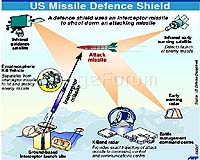| . |  |
. |
Riyadh (AFP) Oct 1, 2009 Saudi Arabia is weighing buying an advanced Russian missile system to shore up its defence against a potentially nuclear Iran, Gulf analysts and diplomats said. They said Moscow and Riyadh are close to sealing a deal on a multi-billion-dollar weapons package that could include Russia's advanced S-400 missile defence system. It is the newest version of the S-300 long-range surface to air missile system that Moscow has been in discussion for several years to sell to Iran, which denies Western charges of aiming to become a nuclear power. But heavy Western and Israeli pressure and a possibly more lucrative deal with Riyadh have persuaded Moscow not to go through with that sale to Tehran, diplomats in the Gulf said on condition of anonymity. "The Saudis would rather this weapon system not be sold to Iran or Syria," another possible buyer, said Theodore Karasik, director of research at the Dubai-based Institute for Near East and Gulf Military Analysis. The S-400 missile defence system could be a part of a much larger deal with Russia that would signify an important diversification of Saudi arms purchasing from its traditional suppliers -- Britain, France and the United States. On August 29, Russia's Interfax news agency said a two-billion-dollar arms package for the Saudis could include up to 150 helicopters -- 30 Mi-35 attack helicopters and up to 120 Mi-17 transport helicopters -- more than 150 T-90S tanks, 250 BMP-3 infantry fighting vehicles and "several dozen" air defence systems. Contracts for the sale of the tanks and the helicopters "could be signed as soon as this year," an unnamed source told Interfax. With the S-400, and a reported plan to buy new US F-15 fighters, the Saudis are seeking to plug gaps in their overall defence capabilities vis-a-vis Iran, Karasik said. In early September, the well-informed US arms business blog DoDBuzz reported that Riyadh is close to finalising a contract for 72 F-15E Strike Eagles with advanced radar and armaments. Saudi officials are increasingly concerned that Western pressure has failed to prevent Iran's development of nuclear know-how, analysts and diplomats said. Like Western governments, Riyadh is unconvinced by Tehran's insistence that its nuclear ambitions are entirely peaceful. The Saudis already have French and US missile defence equipment, including US Patriot batteries. But the S-400 is believed to have a much greater range than the Patriot. The Saudis seek several advantages from the deal, first being a way of persuading Moscow to put pressure on Tehran to rein in its nuclear ambitions. "I think the Saudis see it as a way to get the Russians to be a back channel to Iran," Karasik said. Another aim may be to signal unhappiness with some of the problems associated with purchases from traditional suppliers, like Washington's bureaucratic and politicised approval process for foreign arms sales. Analysts and diplomats say it is still unclear just what the attack helicopters, tanks, armoured personnel carriers and other equipment are for. Some believe the purchases could relate to bureaucratic rivalries between the powerful National Guard, controlled directly by the king, the ministry of defence and the ministry of interior.
Share This Article With Planet Earth
Related Links Learn about missile defense at SpaceWar.com Learn about nuclear weapons doctrine and defense at SpaceWar.com All about missiles at SpaceWar.com Learn about the Superpowers of the 21st Century at SpaceWar.com
 US must reach out to Russia on missile defense: Obama
US must reach out to Russia on missile defense: ObamaWashington (AFP) Sept 29, 2009 President Barack Obama said Tuesday it was important to work with Russia on a new generation missile shield, following his abandonment of an earlier US system that Moscow opposed, in Eastern Europe. His comments came hours after Russia asked for guarantees from Washington that the new plan, targeting Iranian short- and medium-range missiles, would not threaten its own security. "It is im ... read more |
|
| The content herein, unless otherwise known to be public domain, are Copyright 1995-2009 - SpaceDaily. AFP and UPI Wire Stories are copyright Agence France-Presse and United Press International. ESA Portal Reports are copyright European Space Agency. All NASA sourced material is public domain. Additional copyrights may apply in whole or part to other bona fide parties. Advertising does not imply endorsement,agreement or approval of any opinions, statements or information provided by SpaceDaily on any Web page published or hosted by SpaceDaily. Privacy Statement |